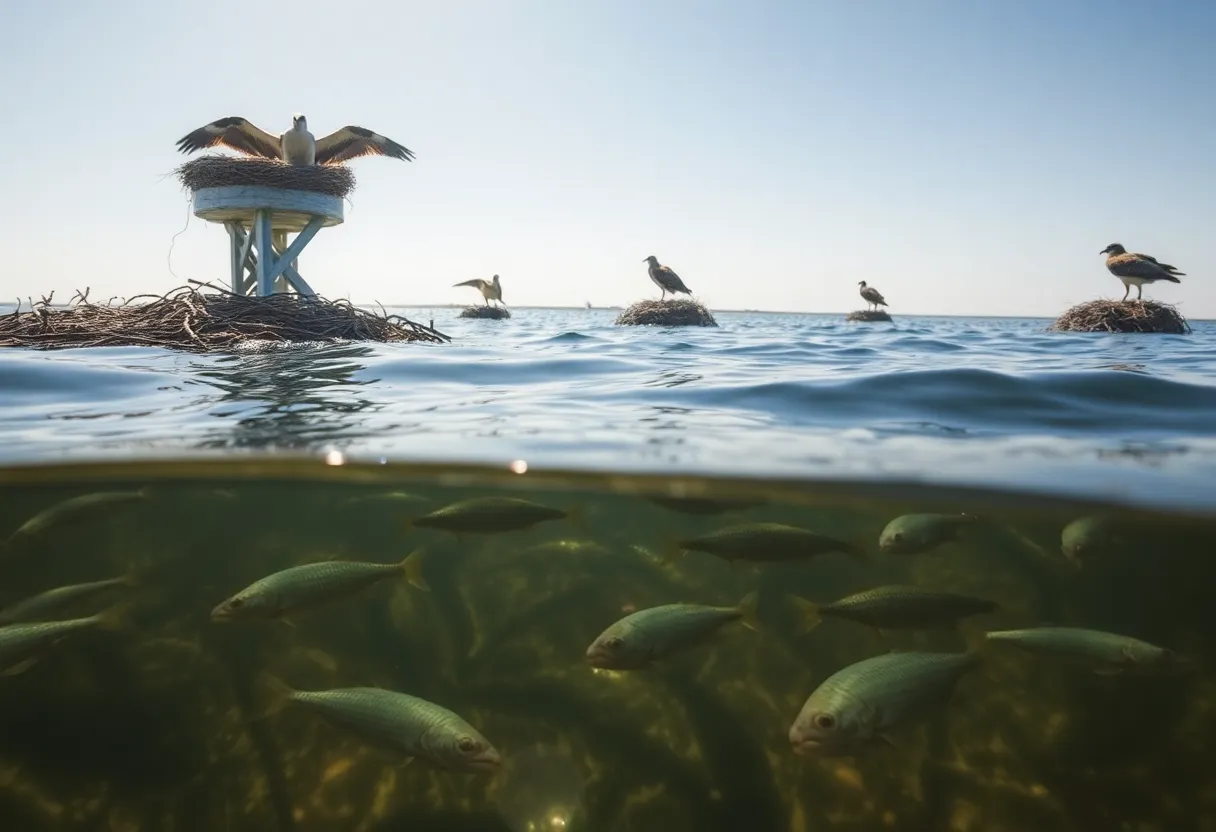News Summary
The osprey population in the Chesapeake Bay is declining due to a shortage of menhaden, a crucial fish in their diet. Reproductive rates have dropped dramatically, with current averages at 0.6 chicks per pair, far below the necessary 1.15 for stability. Overfishing and environmental factors like climate change are contributing to this crisis, prompting conservationists to call for immediate action to safeguard these birds and the ecosystem’s health.
Chesapeake Bay Facing Osprey Population Crisis Linked to Menhaden Shortage
The osprey population in the Chesapeake Bay is experiencing a significant decline, primarily due to a shortage of menhaden, a vital fish in their diet. Biologist Bryan Watts from the College of William & Mary has documented alarming decreases in osprey reproductive rates, indicating that these fish-eating raptors are failing to produce enough chicks to sustain their population.
Current reproductive rates in menhaden-dependent areas of the Chesapeake Bay have dropped to below 0.6 chicks per pair, a stark contrast to the historical average of 1.15 chicks needed for population stability. This decline is particularly pronounced in regions where menhaden availability has diminished, which is crucial for the birds during their breeding season.
Impact of Overfishing
Menhaden, which play a critical role in the marine food chain, have been overfished, raising concerns among conservationists. U.S. fishermen have caught at least 1.1 billion pounds of menhaden annually since 1951, using the fish for products like fish oil and fish meal. However, this fishing pressure is believed to be contributing to the declining osprey population.
Challenges in Reproduction
Studies have revealed poor breeding performance among ospreys in several Chesapeake Bay locations. Observations indicate that ospreys in this region have a significantly lower success rate in raising chicks compared to those living in Washington, D.C. This suggests a direct correlation between the availability of menhaden and the reproductive success of ospreys. Without adequate food sources, ospreys struggle to care for and fledge their young effectively.
External Factors Affecting Populations
In addition to the shortage of menhaden, external factors such as climate change and pollution are being scrutinized as potential contributors to the declining osprey population. Some representatives from the fishing industry argue that these broader environmental changes may play a more significant role than current fishing practices.
Recent weather patterns, including extreme heat and sudden cold snaps, have also impacted the feeding habits and survival rates of both adult and juvenile ospreys. These conditions further complicate the challenges faced by the species in finding enough food to thrive.
Conservation Efforts Underway
Environmental advocates are keenly aware that without immediate intervention, the osprey population could face historic lows reminiscent of the DDT era when ospreys were nearly eliminated. As part of the response to this crisis, the Atlantic States Marine Fisheries Commission is contemplating new fisheries management rules to address menhaden harvesting in the Chesapeake Bay.
In a survey conducted in 2023, it was found that only nine pairs of ospreys were present in an area that once supported 83 pairs. This drastic decline illustrates the urgency of the situation and the need for effective conservation measures to ensure the survival of this indicator species.
Conclusion
The osprey’s decline amid the menhaden shortage represents a critical issue for not just the species itself, but also the health of the broader ecosystem. As the Chesapeake Bay faces these challenges, ongoing studies, conservation efforts, and potential regulatory changes will be vital in addressing the factors affecting osprey populations and restoring their numbers.
Deeper Dive: News & Info About This Topic
HERE Resources
Virginia Ospreys Face Decline Due to Menhaden Shortage and New Nesting Threats
Declining Osprey Populations in Virginia’s Chesapeake Bay
Additional Resources
- NBC Washington: Osprey Population Thrives in DC, Plummets in Chesapeake Bay
- Wikipedia: Osprey
- Chesapeake Bay Magazine: Osprey Obsession
- Google Search: Osprey Conservation
- Bay Journal: Osprey Nest Failures Linked to Menhaden Shortage
- Google Scholar: Osprey Population Decline
- 13 News Now: Osprey Population Research in Virginia
- Encyclopedia Britannica: Osprey

Author: STAFF HERE VIRGINIA BEACH WRITER
The VIRGINIA BEACH STAFF WRITER represents the seasoned team at HEREVirginiaBeach.com, your trusted source for actionable local news and information in Virginia Beach, Virginia Beach City, and beyond, delivering "news you can use" with comprehensive coverage of product reviews for personal and business needs, local business directories, politics, real estate trends, neighborhood insights, and state news impacting the region—supported by years of expert reporting and strong community input, including local press releases and business updates, while offering top reporting on high-profile events like the Virginia Beach Neptune Festival, East Coast Surfing Championship, and military homecoming celebrations, alongside key organizations such as the Virginia Aquarium, Virginia Beach Convention Center, and Oceana Naval Air Station, plus leading businesses in tourism and defense like Busch Gardens and Northrop Grumman, and as part of the broader HERE network including HEREWilliamsburg.com, providing credible, in-depth insights into Virginia's vibrant landscape. HERE Virginia Beach HERE Williamsburg





